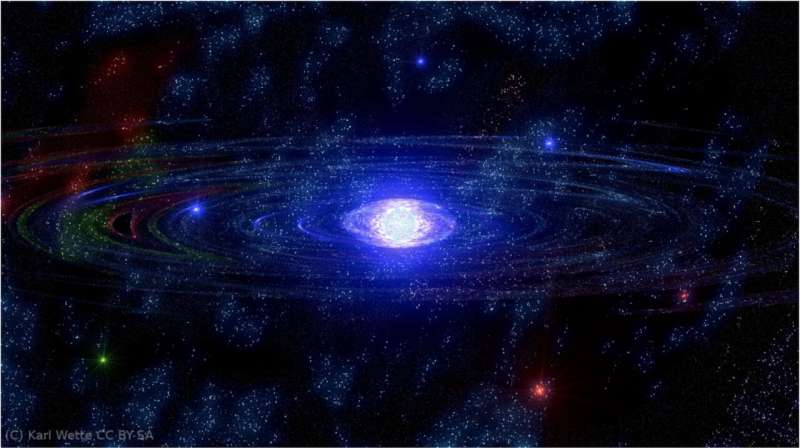Rapidly rotating neutron stars may be “humming” continuous gravitational waves. Credit: K. Wette.
When searching for lost keys, there are a number of possible strategies. You might try moving from room to room, casting your eye over every flat surface, in the hope of spotting the missing keys. Of course, this assumes that they are somewhere in plain sight; if they're hidden under a newspaper or have fallen behind the sofa, you'll never spot them. So which is the best strategy?
Scientists face a similar conundrum in the hunt for gravitational waves—ripples in the fabric of space and time—from rapidly spinning neutron stars. These stars are the densest objects in the universe and, provided they're not perfectly spherical, emit a very faint "hum" of continuous gravitational waves. Hearing this "hum" would allow scientists to peer deep inside a neutron star and discover its secrets, yielding new insights into the most extreme states of matter. However, our very sensitive "ears"—4-kilometer-sized detectors using powerful lasers—haven't heard anything yet.
Part of the challenge is that, like the missing keys, scientists aren't sure of the best search strategy. Most previous studies have taken the "room-to-room" approach, trying to find continuous gravitational waves in as many different places as possible. But this means you can only spend a limited amount of time listening for the telltale hum in any one location—in the same way that you can only spend so long staring at your coffee table trying to discern a key-shaped object. And since the "hum" is very quiet, there's a good chance you won't even hear it.
In a recently published study, a team of scientists, led by postdoctoral researcher Karl Wette from the ARC Center of Excellence for Gravitational Wave Discovery (OzGrav) at the Australian National University, tried the "where else could they be but the kitchen?" approach.
Wette explains: "We took an educated guess at a specific location where continuous gravitational waves might be, based in part on what we already know about pulsars—they're like neutron stars but send out radio waves instead of continuous gravitational waves. We hypothesized that there would be continuous gravitational waves detected near pulsar radio waves." Just like guessing that your missing keys will probably be close to your handbag or wallet.
Using existing observational data, the team spent a lot of time searching in this location (nearly 6,000 days of computer time) listening carefully for that faint hum. They also used graphic processing units—specialist electronics normally used for computer games—to run their algorithms super-fast.
"Our search was significantly more sensitive than any previous search for this location," says Wette. "Unfortunately, we didn't hear anything, so our guess was wrong this time. It's back to the drawing board for now, but we'll keep listening."
More information: Karl Wette et al. Deep exploration for continuous gravitational waves at 171–172 Hz in LIGO second observing run data, Physical Review D (2021). DOI: 10.1103/PhysRevD.103.083020
Journal information: Physical Review D
























